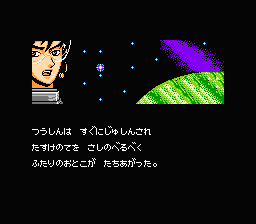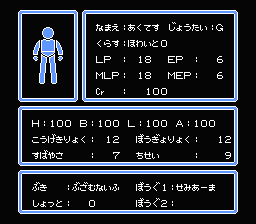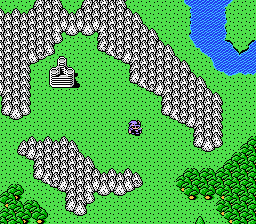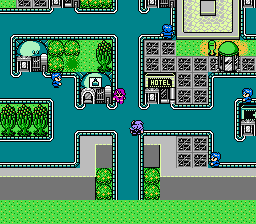Retro Replay Review
Gameplay
STED: Iseki Wakusei no Yabō delivers a robust turn-based combat system viewed entirely from a first-person perspective, a design choice that puts you squarely in the boots of your starship crew. Each encounter highlights only the active attacker and the targeted enemy, maintaining focus and clarity. The gameplay loop revolves around strategic decision-making: choosing which enemy to target, managing limited ESP magic points, and timing energy weapon recharges to maximize damage output.
(HEY YOU!! We hope you enjoy! We try not to run ads. So basically, this is a very expensive hobby running this site. Please consider joining us for updates, forums, and more. Network w/ us to make some cash or friends while retro gaming, and you can win some free retro games for posting. Okay, carry on 👍)
Outside of combat, exploration and resource management take center stage. Towns serve as bustling hubs where you can purchase weapons—from standard ballistic rifles to futuristic energy blasters—recharge batteries, stock up on defensive gear, and learn powerful ESP abilities. The depth of the equipment system encourages you to experiment: balancing heavy armor that reduces agility against lighter protection that allows quicker action.
Injuries in STED are handled with surprising granularity. Different body parts—arms, legs, torso—can sustain damage, affecting your characters’ performance. A wounded leg might slow your turn order, while an arm injury can reduce attack accuracy. The ability to treat specific injuries with targeted medical items adds a layer of realism and forces you to plan ahead before heading back into the fray.
The pacing of enemy encounters is well calibrated. Early on, monster activity spikes when you land on the distressed planet, serving as an introductory gauntlet that teaches you the ropes of party coordination and resource conservation. As you progress deeper into the planet’s ruins, tougher foes and environmental hazards demand more nuanced tactics. Overall, the gameplay loop is addictive, balancing risk and reward in a way that keeps you coming back for just one more battle.
Graphics
Graphically, STED opts for detailed pixel art environments blended with modern lighting effects. The lush jungles and derelict alien ruins of the distressed planet are rendered with vibrant colors, creating a visually distinct contrast between the natural world and enigmatic ancient technology. This stylized approach gives each area its own personality and invites exploration.
Character sprites are well designed, featuring distinctive silhouettes that make it easy to identify allies and enemies in combat. While the first-person perspective limits on-screen character animation during battles, the brief attack and damage animations are fluid and impactful, providing satisfying visual feedback with each successful hit or magical blast.
The user interface strikes a comfortable balance between retro charm and clarity. Menus for inventory management, ESP selection, and status checks are laid out logically, with crisp icons and readable text. During battles, the HUD remains minimalist, highlighting only essential information such as turn order, HP, and energy levels, so your focus stays on the unfolding skirmish.
Transitions between exploration, shop screens, and combat are seamless, supported by subtle screen wipe effects and music cues that enhance immersion. While some textures in larger town areas can appear slightly repetitive, the game’s overall visual cohesion and attention to detail make for a compelling aesthetic experience.
Story
The narrative of STED: Iseki Wakusei no Yabō kicks off on Star Date 0991, when the peaceful Milky Way is rocked by an unprecedented surge in monster activity. A cryptic distress signal from a nearby planet sets the stage for an interstellar rescue mission, blending classic sci-fi tropes with an undercurrent of cosmic mystery. This premise immediately hooks players, promising both high-stakes action and deep lore.
As your team investigates the abandoned outposts and ancient ruins, you uncover fragments of a lost civilization. Environmental storytelling—via scattered datapads, crumbling murals, and audio logs—paints a picture of a forgotten world besieged by its own creations. These discoveries provide context for each dungeon and keep the narrative momentum steady between combat encounters.
Character development is woven into both dialogue choices and spontaneous in-field banter. Each crew member brings a unique perspective: the stoic captain driven by duty, the tech specialist fascinated by alien robotics, and the empathic healer haunted by past failures. Their interactions evolve over time, creating emotional stakes that make the final revelations all the more meaningful.
Pacing is generally well handled, although some mid-game fetch quests can feel repetitive. Nevertheless, significant story beats—such as decoding the distress signal’s true origin or confronting the mastermind behind the monster outbreak—offer memorable moments that justify the occasional padding. By the end credits, you’ll have a satisfying sense of closure, even if a few mysteries remain tantalizingly unresolved.
Overall Experience
STED: Iseki Wakusei no Yabō captures the essence of classic JRPG design while introducing fresh tactical and narrative elements. Its blend of first-person turn-based combat, detailed injury management, and richly rendered environments makes for an engaging journey from start to finish. Whether you’re a veteran strategist or a newcomer to the genre, the game offers depth without overwhelming complexity.
The combination of challenging battles, resource management, and story-driven exploration ensures that each play session feels rewarding. While minor pacing hiccups and occasional UI repetition may surface, they are outweighed by the game’s strong world-building, memorable characters, and strategic combat mechanics. The ability to customize your team’s gear and ESP abilities also adds significant replay value.
From the moment you answer that mysterious distress call to the climactic showdown beneath the planet’s surface, STED keeps you invested. The game strikes a fine balance between nostalgia and innovation, offering a polished experience that stands out among contemporary turn-based RPGs. Its visual flair and narrative depth make it a compelling addition to any sci-fi fan’s library.
In conclusion, STED: Iseki Wakusei no Yabō is a must-play for those who appreciate methodical combat, intricate storytelling, and immersive world design. Its strengths far outshine its minor flaws, resulting in an overall experience that both challenges and delights. If you’re in the market for a thoughtful, richly detailed RPG that rewards strategic play, look no further than this intergalactic adventure.
 Retro Replay Retro Replay gaming reviews, news, emulation, geek stuff and more!
Retro Replay Retro Replay gaming reviews, news, emulation, geek stuff and more!









Reviews
There are no reviews yet.